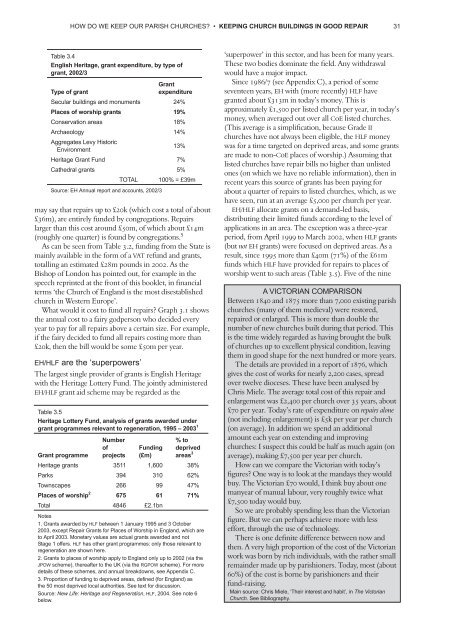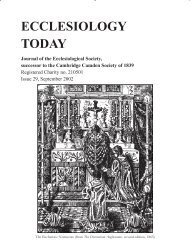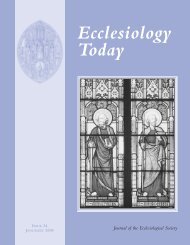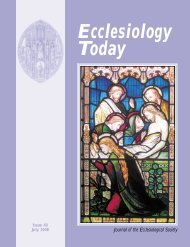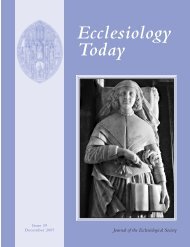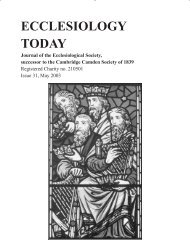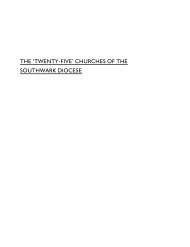PARISH CHURCHES? how do we keep our - Ecclesiological Society
PARISH CHURCHES? how do we keep our - Ecclesiological Society
PARISH CHURCHES? how do we keep our - Ecclesiological Society
You also want an ePaper? Increase the reach of your titles
YUMPU automatically turns print PDFs into web optimized ePapers that Google loves.
HOW DO WE KEEP OUR <strong>PARISH</strong> <strong>CHURCHES</strong>? • KEEPING CHURCH BUILDINGS IN GOOD REPAIR 31<br />
Table 3.4<br />
English Heritage, grant expenditure, by type of<br />
grant, 2002/3<br />
Grant<br />
Type of grant<br />
expenditure<br />
Secular buildings and monuments 24%<br />
Places of worship grants 19%<br />
Conservation areas 18%<br />
Archaeology 14%<br />
Aggregates Levy Historic<br />
Environment<br />
13%<br />
Heritage Grant Fund 7%<br />
Cathedral grants 5%<br />
TOTAL 100% = £39m<br />
S<strong>our</strong>ce: EH Annual report and accounts, 2002/3<br />
may say that repairs up to £20k (which cost a total of about<br />
£36m), are entirely funded by congregations. Repairs<br />
larger than this cost around £50m, of which about £14m<br />
(roughly one quarter) is found by congregations. 5<br />
As can be seen from Table 3.2, funding from the State is<br />
mainly available in the form of a VAT refund and grants,<br />
totalling an estimated £28m pounds in 2002. As the<br />
Bishop of Lon<strong>do</strong>n has pointed out, for example in the<br />
speech reprinted at the front of this booklet, in #nancial<br />
terms ‘the Church of England is the most disestablished<br />
church in Western Europe’.<br />
What would it cost to fund all repairs? Graph 3.1 s<strong>how</strong>s<br />
the annual cost to a fairy godperson who decided every<br />
year to pay for all repairs above a certain size. For example,<br />
if the fairy decided to fund all repairs costing more than<br />
£20k, then the bill would be some £50m per year.<br />
EH/HLF are the ‘superpo<strong>we</strong>rs’<br />
The largest single provider of grants is English Heritage<br />
with the Heritage Lottery Fund. The jointly administered<br />
EH/HLF grant aid scheme may be regarded as the<br />
Table 3.5<br />
Heritage Lottery Fund, analysis of grants awarded under<br />
grant programmes relevant to regeneration, 1995 – 2003 1<br />
Grant programme<br />
Number<br />
of<br />
projects<br />
Funding<br />
(£m)<br />
%to<br />
deprived<br />
areas 3<br />
Heritage grants 3511 1,600 38%<br />
Parks 394 310 62%<br />
Townscapes 266 99 47%<br />
Places of worship 2 675 61 71%<br />
Total 4846 £2.1bn<br />
Notes<br />
1. Grants awarded by HLF bet<strong>we</strong>en 1 January 1995 and 3 October<br />
2003, except Repair Grants for Places of Worship in England, which are<br />
to April 2003. Monetary values are actual grants awarded and not<br />
Stage 1 offers. HLF has other grant programmes: only those relevant to<br />
regeneration are s<strong>how</strong>n here.<br />
2. Grants to places of worship apply to England only up to 2002 (via the<br />
JPOW scheme), thereafter to the UK (via the RGPOW scheme). For more<br />
details of these schemes, and annual break<strong>do</strong>wns, see Appendix C.<br />
3. Proportion of funding to deprived areas, defined (for England) as<br />
the 50 most deprived local authorities. See text for discussion.<br />
S<strong>our</strong>ce: New Life: Heritage and Regeneration, HLF, 2004. See note 6<br />
below.<br />
‘superpo<strong>we</strong>r’ in this sector, and has been for many years.<br />
These two bodies <strong>do</strong>minate the #eld. Any withdrawal<br />
would have a major impact.<br />
Since 1986/7 (see Appendix C), a period of some<br />
seventeen years, EH with (more recently) HLF have<br />
granted about £313m in today’s money. This is<br />
approximately £1,500 per listed church per year, in today’s<br />
money, when averaged out over all CoE listed churches.<br />
(This average is a simpli#cation, because Grade II<br />
churches have not always been eligible, the HLF money<br />
was for a time targeted on deprived areas, and some grants<br />
are made to non-CoE places of worship.) Assuming that<br />
listed churches have repair bills no higher than unlisted<br />
ones (on which <strong>we</strong> have no reliable information), then in<br />
recent years this s<strong>our</strong>ce of grants has been paying for<br />
about a quarter of repairs to listed churches, which, as <strong>we</strong><br />
have seen, run at an average £5,000 per church per year.<br />
EH/HLF allocate grants on a demand-led basis,<br />
distributing their limited funds according to the level of<br />
applications in an area. The exception was a three-year<br />
period, from April 1999 to March 2002, when HLF grants<br />
(but not EH grants) <strong>we</strong>re focused on deprived areas. As a<br />
result, since 1995 more than £40m (71%) of the £61m<br />
funds which HLF have provided for repairs to places of<br />
worship <strong>we</strong>nt to such areas (Table 3.5). Five of the nine<br />
A VICTORIAN COMPARISON<br />
Bet<strong>we</strong>en 1840 and 1875 more than 7,000 existing parish<br />
churches (many of them medieval) <strong>we</strong>re restored,<br />
repaired or enlarged. This is more than <strong>do</strong>uble the<br />
number of new churches built during that period. This<br />
is the time widely regarded as having brought the bulk<br />
of churches up to excellent physical condition, leaving<br />
them in good shape for the next hundred or more years.<br />
The details are provided in a report of 1876, which<br />
gives the cost of works for nearly 2,200 cases, spread<br />
over t<strong>we</strong>lve dioceses. These have been analysed by<br />
Chris Miele. The average total cost of this repair and<br />
enlargement was £2,400 per church over 35 years, about<br />
£70 per year. Today’s rate of expenditure on repairs alone<br />
(not including enlargement) is £5k per year per church<br />
(on average). In addition <strong>we</strong> spend an additional<br />
amount each year on extending and improving<br />
churches: I suspect this could be half as much again (on<br />
average), making £7,500 per year per church.<br />
How can <strong>we</strong> compare the Victorian with today’s<br />
#gures? One way is to look at the mandays they would<br />
buy. The Victorian £70 would, I think buy about one<br />
manyear of manual lab<strong>our</strong>, very roughly twice what<br />
£7,500 today would buy.<br />
So <strong>we</strong> are probably spending less than the Victorian<br />
#gure. But <strong>we</strong> can perhaps achieve more with less<br />
effort, through the use of technology.<br />
There is one de#nite difference bet<strong>we</strong>en now and<br />
then. A very high proportion of the cost of the Victorian<br />
work was born by rich individuals, with the rather small<br />
remainder made up by parishioners. Today, most (about<br />
60%) of the cost is borne by parishioners and their<br />
fund-raising.<br />
Main s<strong>our</strong>ce: Chris Miele, ‘Their interest and habit’, in The Victorian<br />
Church. See Bibliography.


